As a landowner or leaser, knowing how to attract deer to your property and hold them longer can be a game-changer and increase your chances of bagging a big buck.
In this article, we will discuss some effective tips and strategies that can help you attract deer to your hunting property.
So, let's dive in and discover how to bring deer to your yard!
Provide Food and Water Sources:
Food and water sources are two of the most important factors when trying to attract deer to your block of land.
Deer are herbivores and require a diverse range of food sources to thrive.
1. Planting Food Plots:
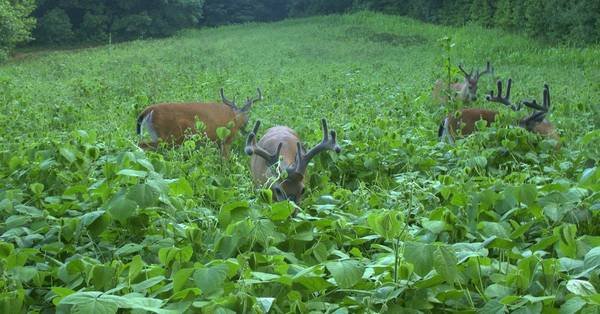
Planting food plots would be considered the fastest way to attract deer to your property.
Planing vegetation such as clover, wheat, and soybeans can provide deer with the necessary nutrition they need.
Where and when to plant food plot?
You should choose an area that receives enough sunlight and has the appropriate soil conditions.
It's also important to plant the food plot early enough in the year (late summer to early fall depending on the plant species) to give the plants time to grow before deer season.
Pros:
- A very effective way to consistently bring deer onto the property.
- Helps you to ensure a healthy population due to access to food sources and cover.
Cons:
- Requires significant preparation work, with soil preparation, planting and maintenance.
- Can take over a significant amount of space on your property to be able to do it effectively.
2. Plant Fruit Trees:

Planting fruit trees on your property is one of the best ways to keep them coming back for more.
As deer are known to have a sweet tooth and will be attracted to any food that satisfies their sugar cravings.
What trees should you plant?
Apple and persimmon trees are some of the most preferred fruit trees by deer.
If you want to maximize your chances of attracting them, plant a variety of fruit trees with different ripening periods.
Why?
This will ensure that there is always something sweet and ripe to eat throughout the year, and the deer are more inclined to pass through more consistently.
Pros:
- Generally a cost-effective and low maintenance way to provide food for deer.
- Can be aesthetically pleasing, whilst offering additional benefits to the property such as shade, privacy and soil stability.
Cons:
- Can also attract other unwanted wildlife, including predators, birds and pests.
- May take some significant time or investment to initially establish depending on the conditions of the property.
3. Create a Water Source:
Like any other animal, deer need water to survive. They will often travel long distances to get to a water source, especially during dry seasons.
By creating a water source on your property, you offer another level of comfort and dependence for deer.
What is a water source?
A natural stream, pond, or creek on your property is ideal for attracting deer.
If you don't have any natural water sources, you can create your own by digging a small pond or installing a water feature somewhere on your block.
Pros:
- Offers a reliable water source for deer which is essential to their health and survival in general.
- Allows the opportunity to study deer behavior and movements, by setting up trail cameras next to drinking areas.
Cons:
- Can be expensive or time consuming to create (and monitor) depending on the size and extent of the water source being provided.
- May attract other unwanted wildlife into the area.
4. Baiting (If Legal In Your Area):

Baiting is a popular technique used to attract deer to a particular location.
The process involves placing food or other attractive scents in a designated area to lure deer in for hunting, observation, or photography purposes.
What deer attractants should you use?
Some common types of bait used for deer include corn, apples, and salt licks (or other mineral compositions).
You can setup deer feeders to spread them around your land without much effort.
It's important to check the local hunting regulations as baiting may be illegal in some areas.
Pros:
- Can be a highly effective way to attract deer, consistently.
- Offers the opportunity to study deer behavior and movements, by setting up trail cameras next to designated baiting areas.
Cons:
- Can interrupt natural feeding processes, and create an over-reliance.
- May also bring in unwanted animals, including bears (if in the area).
- Can be illegal in some areas, and at different times of the year.
Create a Safe and Comfortable Habitat for Deer
Deer are prey animals which rely on taking safety measures in order to survive. They are also creatures of habit.
So if they find areas or travel routes that offer them a sense of safety, they are more likely to use them, and more often.
5. Create Cover:
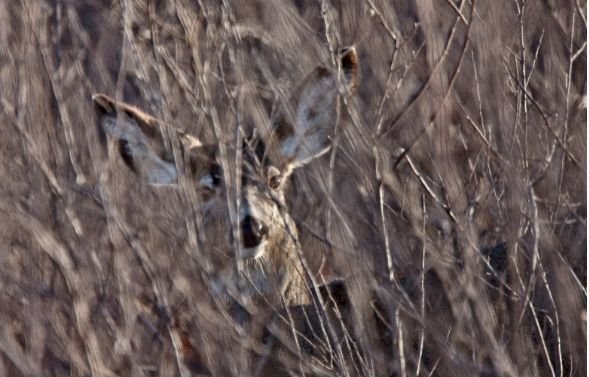
Deer need a safe and comfortable habitat to thrive.
If you provide natural cover such as bushes, shrubs, and trees, it can give deer the necessary cover to hide from predators and feel safe.
But note:
It's also important to maintain a clean and healthy environment by removing any invasive species or dead trees that can cause safety hazards.
Places to be able to hide, not only from other animals and hunters, but also from the elements.
Let me explain:
Throughout the year through the varying weather conditions deer will look for places to tuck away from heavy rain, heavy wind and even hotter sunny days.
This added cover goes a long way to not just bringing deer to your property, but to also keep them there longer!
Pros:
- Gives the deer places to bed down and hide away, making it more comfortable for them to stay on the property for extended periods of time.
- Can improve overall deer health, by creating less stress and allowing areas for fawns to evade predators.
Cons:
- Can be expensive and time consuming to create.
- Can create areas on the property that are less safe due to creating dark spots and low visibility areas.
6. Ensure Travel Routes:

Via nyantler-outdoors.com
When creating a habitat for deer, it's important to consider the layout of your property.
Let me explain:
Deer tend to follow the same (or similar) patterns year after year.
You should identify the areas where deer are most likely to travel and set up food plots and deer stands in those areas.
Also taking into consideration what the adjoining land areas look like will help you to understand where they are likely to come in from, and where they want to head to.
Pros:
- Creates a safer and more comfortable area for deer to pass through regularly.
- Keeps the deer funneling through certain areas which makes it easier to monitor.
- Offers areas to set up tree blinds and ground blinds during hunting season.
Cons:
May be ineffective if deer are accustomed to traveling through a different area, or if the travel route is not aligned with transit areas on adjoining properties.
7. Avoid Excess Human (and Pet) Influence:
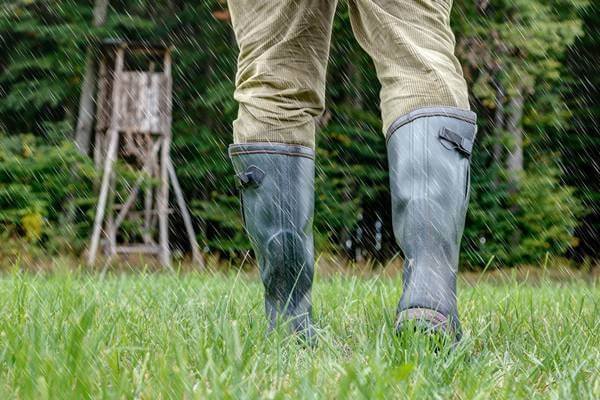
Whilst it’s important to create a physical natural habitat for deer to move through, it is also important to minimize human activity in these areas.
Deer are skittish and don’t love loud noises or movements.
Keep human scent away
Human and human-related activity is likely to keep deer away.
So wherever possible, especially in the areas of your property primed for deer attraction, keep your movements, DIY projects and loud communication to a minimum.
This can also be said for bright outdoor lighting.
And pet scents away

Another aspect to consider is if you have a pet at home.
Keeping your pet and any pet scents away from the deer trail is important, as these smells are likely to come across as potentially threatening to deer.
Pros:
Minimizing the risk of injury or disease due to less physical interactions.
Reduces the chance of deer being spooked off or avoiding the area due to the known potential threat of humans on the property.
Cons:
- Reduces the chance of deer becoming more comfortable with human presence, which can make them less skittish, and easier to hunt.
- Requires limited access to areas of your property at certain times.
8. Implement a Deer Management Program:
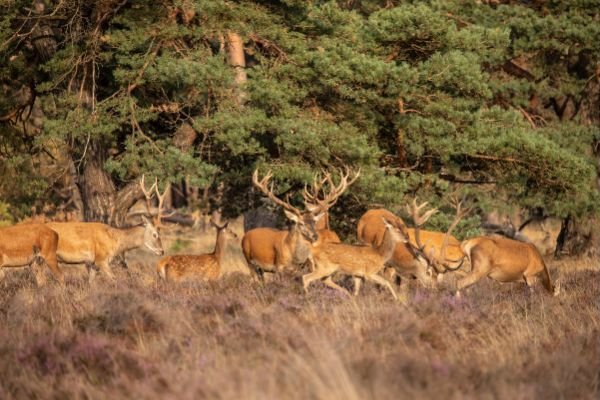
Implementing a deer management program can help attract deer to your property by ensuring that the deer population is healthy and well-maintained.
What does it include?
It includes monitoring the deer population, harvesting the appropriate number of deer each season, and maintaining proper nutrition levels in the deer's diet.
How to monitor deer?
To monitor the deer population, you can use trail cameras to track their movement patterns and identify the size and health of the deer in the area.
This can help you determine the appropriate number of deer to harvest each season.
What’s more?
In addition to monitoring the deer population, it's important to maintain proper nutrition levels in the deer's diet.
This can be achieved by planting the right food plots and providing supplemental feed as needed.
Pros:
- Help to maintain a healthy and sustainable deer population in the area.
- Can also improve surrounding wildlife and vegetation by having a balanced ecosystem.
Cons:
- Can be expensive and time consuming to maintain.
- Has the change of negatively impacting other wildlife populations if incorrectly managed.
9. Use Scents and Attractants:
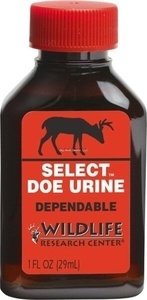
Via ebay.com
Using scents and attractants can also be an effective way to attract deer to your hunting property.
Here’s why:
Deer have a strong sense of smell and using natural scents such as doe urine or buck lure can pique their interest and draw them in.
There are also various food-based attractants such as corn or apple that can lure deer in (if allowed in your area).
But DON’T use frequently
When using scents and attractants, it's important to use them strategically.
You should use them in areas where deer are known to travel and avoid using them too frequently, as deer can become accustomed to them over time.
Pros:
- Can help attract deer to the area and keep them longer out of curiosity.
- Can be obtained from most outdoors and hunting stores for a low cost.
Cons:
- May affect some of the natural feeding and breeding patterns if overused.
- Not always effective, and usually relies on putting in small localized areas.
10. Install Trail Cameras:
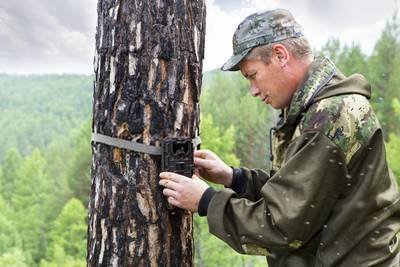
Why do you need trail cameras?
Installing trail cameras can help you monitor the deer population on your property and help you identify where the deer are spending their time.
This can help you determine the best locations for food plots or deer stands, as well as help you track the movement patterns of the deer.
Where to place them?
When installing trail cameras, look for areas with heavy deer traffic, such as game trails or near food sources.
You should also make sure that your cameras are well-hidden and not easily visible to humans or animals.
Here’s the best part:
In addition to monitoring deer activity, trail cameras can also help you identify individual deer.
By studying the unique antler patterns and physical characteristics of deer in your area, you can determine which ones are worth targeting during hunting season.
Pros:
- Provides accurate information on deer and wildlife sightings on your property.
- Good for general surveillance of the area surrounding your home.
Cons:
- Adding enough good quality cameras can add up to being expensive.
- Risk of cameras being vandalized or stolen if noticed by people.
11. Remove or Re-organize Fences:

We all like to have our property boundaries nicely defined, however serious and tricky fences can be a deterrent for deer.
Removing fences (at least in sections) will help to allow deer to pass through easily without much risk.
Another alternative, if you wish to keep the fences up, is to make sure they are deer friendly.
This means easily jumpable, without any real risk of getting tangled up or torn up on them.
How high is the fence?
If you want deer to be able to safely jump over a fence, it is recommended to not make the fence much higher than 1.5 meters tall, or 1.0 meters if you wish for fawns to be able to jump over it.
Pros:
- More deer being able to safely enter the property, using it as a transit route.
- Less maintenance required on maintaining fence security.
Cons:
- Less secure fencing resulting in more unwanted animals entering the property.
- Less likely to keep pets and children in, and unwanted humans (or hunters) out.
Final Words:
Attracting deer to your property can be a rewarding and exciting experience for any hunter.
By following these tips, you can create a habitat that is attractive to deer and keeps them coming back year after year.
Remember to always check your local hunting regulations and obtain any necessary permits before attempting to attract deer to your property.
Do you have any experience with the tips mentioned above, or have any additional tips for attracting deer to your property?
We look forward to hearing from you in the comments below!
